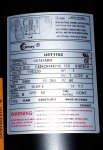- Jun 3, 2008
- 42
I just replaced another motor on my Hayward pump - I put a new one on early LAST season. Its always the same thing... the black wire is toasted inside the round motor cover. I've bought spare motors from several places - always the exact same specs / same box / same 'made in china'.
There is ONE Electric Motor shop in my HomeTown - When you walk in there is a sign on the counter - "We do NOT repair Swimming Pool Motors" - Ain't THAT nice?
Pump is oversized for the pool - runs 9A-9P every day - Auto Pilot Salt pool - motor is controlled by the Auto Pilot - I bring it all inside in the winter (Central PA Area) - Runs 110V
I always keep a spare but this is getting crazy - how long SHOULD one last? Or are they just typical China Junk and I should live with it?
Is the motor having an internal short and the wire melts? Is the wire (14-2 w/ ground stranded) too small?
Just looking for some help - I think I should get a few seasons AT LEAST out of a motor
Here's a pic of the motor - this is the replacement but has the same specs as the OEM Hayward
Thanks for any input...
JS
There is ONE Electric Motor shop in my HomeTown - When you walk in there is a sign on the counter - "We do NOT repair Swimming Pool Motors" - Ain't THAT nice?
Pump is oversized for the pool - runs 9A-9P every day - Auto Pilot Salt pool - motor is controlled by the Auto Pilot - I bring it all inside in the winter (Central PA Area) - Runs 110V
I always keep a spare but this is getting crazy - how long SHOULD one last? Or are they just typical China Junk and I should live with it?
Is the motor having an internal short and the wire melts? Is the wire (14-2 w/ ground stranded) too small?
Just looking for some help - I think I should get a few seasons AT LEAST out of a motor
Here's a pic of the motor - this is the replacement but has the same specs as the OEM Hayward
Thanks for any input...
JS


